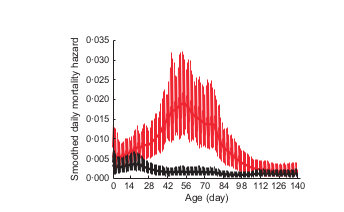Sheep update
Discussion goals
- Sheep study progress
- Objectives under current funding
- How to package / approach existing data
What we've done
(2013-Present)
1. Basic description
Cassirer et al. 2013 JAE



2. Acquired immunity
Plowright et al., 2013 PLoS One



3. Social compartmentalization
Manlove et al., 2014 PRSB


4. Persistence / phase transition
Manlove et al., almost in review




5. Who carries in the wild?
Plowright et al., in prep
6. New strain produces all-age die-off in infected herd
Cassirer et al., in prep



Current MAF Objectives
Objective 1
-ID groups with poor outcomes (Manlove et al., PRSB)
-Inference on carriage rates through time
-ID individual M.ovi carriers (Raina @ Lostine; Frances @ Asotin, Black Butte, Mtn View
- Ewe-group structure / contact patterns (Manlove field data)
-> "vert" vs. "horizontal" transmission
-> force of infection from different demographic groups
- Risk factor analysis
Objective 2: Mechanistic models of carrier etiology
Objective 3: Modeling control strategies
(Plowright et al., 2012 - May 2016)
Sheep society in the wild
Overview
Goal
Quantify social dynamics of bighorn nursery groups with disease
- Associations (who's in a group together)
- Interactions (who touches who)
- Disease progression (symptoms + mortalities)
Methods
- Marked/sampled as many animals as possible overwinter (Frances)
-
Followed up from ~April 20 - July 15
- Locate everybody every day
- Determine lamb status
- Focal follows & scan samples
- Symptoms & carcass recovery
Data collected
| Pop | Year | # Marked (total) | # relocations | # follows / ID'd animals followed | Disease Status |
|---|---|---|---|---|---|
| Asotin | 2013 | 12 / 32 | 554 | infected no transmission | |
| 2014 | 17 / 25 | 1135 | 191 / 883 | infected no transmission | |
| 2015 | 23 / 28 | 1444 | 239 / 1095 | infected no transmission | |
| Black Butte | 2013 | 4 / 13 | 124 | Outbreak | |
| 2014 | 11 / 13 (all recognizable) | 718 | 155 / 581 | New strain | |
| Mtn View | 2015 |
13 / 30 | 516 | 191 / 548 | infected / no transmission |
| Breaks | 2015 | 31 / 300 | 303 | infected / no transmission |


Asotin sampling intensity, 2014


Association networks
(edges = 2 animals in same place at same time)

Interaction network
(direct contacts)

Associations always high, but non-lamb interactions rare

Fission-fusion dynamics
Group sizes and structures


Lamb epidemics
Can we use social network data to draw inference about strength of different potential reservoirs?
Naive model

Slope ~ 0.32

Serial interval ~ 25 days (10 + 15)
f ~ 2/5



Can we use information on time-varying contact rates to separate infection risk from chronic adults vs. infection risk from acute lambs?

Bipartite networks


